In 1962, Prague hosted the World Championships, and, all in all, it was a successful competition for Czechoslovak gymnasts. On the women’s side, the team finished second, and Čáslavská defeated all the Soviet gymnasts except for Latynina in the all-around. She also was the gold medalist on vault and the bronze medalist on floor, while Bosáková was the gold medalist on beam and the silver medalist on bars. On the men’s side, the team took home bronze, and Krbec won gold on vault.
Here’s what the Czechoslovak weekly sports newspaper Stadión reported. As we’ll see, there were 10s being thrown out by individual judges. (No gymnast received enough 10s to receive a final score of 10.) At the same time, the newspaper noted that there were some “thoughtful mistakes” by the judges, but it did not dive into what those mistakes were.
Even if you don’t read the text below, enjoy the photos. Stadión was a highly visual periodical.
Quick Links: Opening Pages | The Men’s Competition | The Women’s Competition | Bonus Content: Štart’s Slovak-Language Coverage
Opening Pages
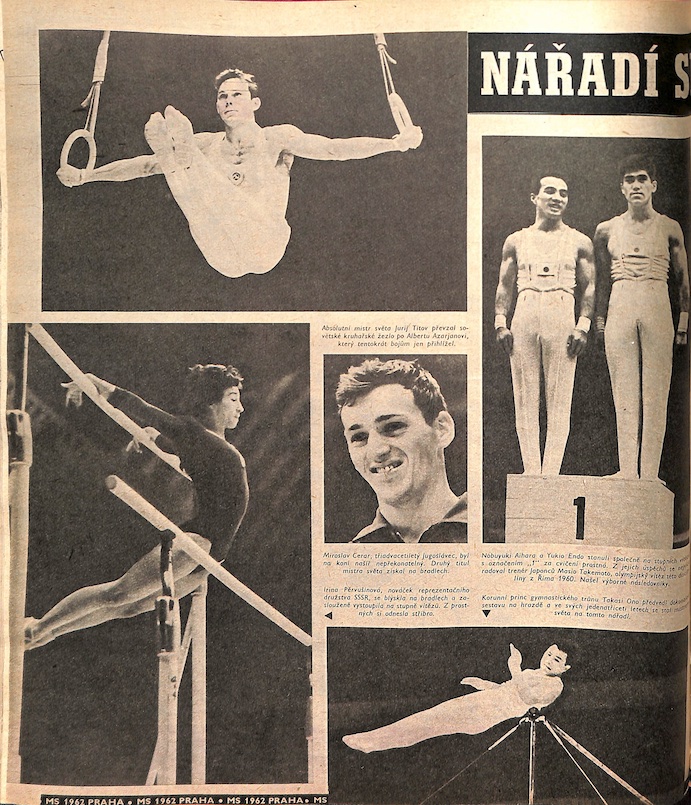
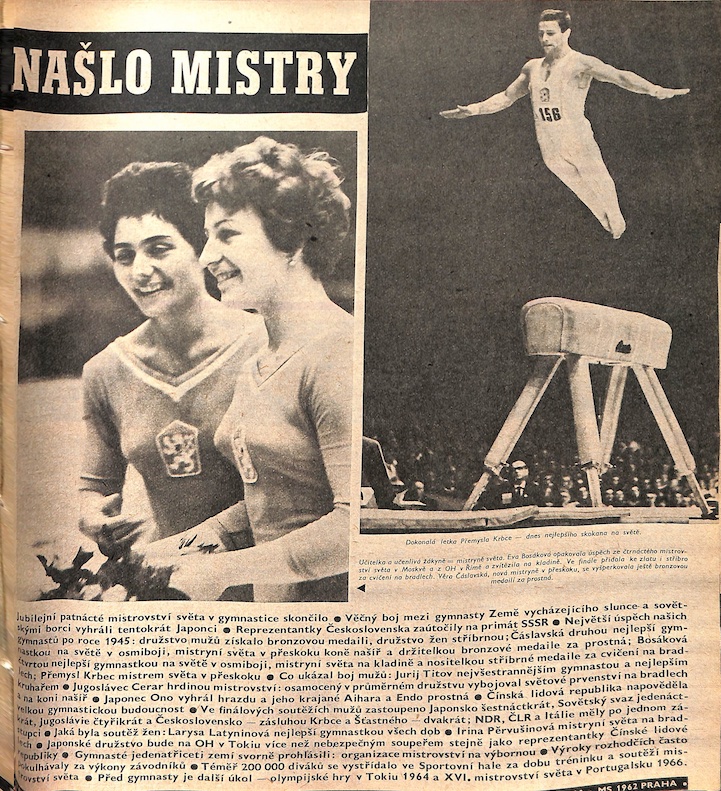
Title: The apparatuses have found their masters
Publication: 13 July 1962
Synopsis
The anniversary 15th World Gymnastics Championships are over • The eternal battle between the gymnasts of the Land of the Rising Sun and the Soviet gymnasts was won by the Japanese this time • Czechoslovak gymnasts attacked the USSR’s primacy • The greatest success of our gymnasts after 1945: men’s team won a bronze medal, women’s team a silver medal; Čáslavská the second best gymnast in the world in the all-around, world champion on vault and winner of the bronze medal for floor exercise; Bosáková the fourth-best gymnast in the world in the all-around, world champion on the balance beam and winner of the silver medal for the uneven bars; Přemysl Krbec the world champion in the vault • What the men’s battle showed: Yuri Titov the most versatile gymnast and the best on pommel horse • Japan’s Ono won on the horizontal bar and his compatriots Aihara and Endo the floor exercise • The People’s Republic of China hinted at a great gymnastic future • In the men’s final competitions Japan was represented sixteen times, the Soviet Union eleven times, Yugoslavia four times and Czechoslovakia twice – thanks to Krbec and Šťastný; GDR, PRC and Italy had one representative each • How was the women’s competition: Larisa Latynina the best gymnast of all time • Irina Pervushinova the world champion on uneven bars • The Japanese team will be more than a dangerous opponent at the Olympic Games in Tokyo, as will the representatives of the People’s Republic of China • Gymnasts from thirty-one countries declared unanimously: the organization of the championships was excellent • The judges’ scores often faltered for the competitors’ performances • Almost 200,000 spectators took turns in the Sports Hall during the training and competitions of the world championships • The gymnasts have another task ahead of them – the Olympic Games in Tokyo 1964 and the 26th World Championships in Portugal in 1966.
Note: The World Championships in 1966 would be moved to Dortmund, Germany.
Jubilejní patnácté mistrovství světa ve gymnastice skončilo • Věčný boj mezi gymnasty Země vycházejícího slunce a sovětskými borci vyhráli tentokrát Japonci • Reprezentantky Československa zaútočily na primát SSSR • Největší úspěch našich gymnastů po roce 1945: družstvo mužů získalo bronzovou medaili, družstvo žen stříbrnou; Čáslavská druhou nejlepší gymnastkou na světě v osmiboji, mistryní světa v přeskoku koně našíř a držitelkou bronzové medaile za prostná; Bosáková čtvrtou nejlepší gymnastkou na světě v osmiboji, mistryní světa na kladině a nositelkou stříbrné medaile za cvičení na bradlech; Přemysl Krbec mistrem světa v přeskoku • Co ukázal boj mužů: Jurij Titov nejvšestrannějším gymnastou a nejlepší a na koni našíř • Japonec Ono vyhrál hrazdu a jeho krajané Aihara a Endo prostná • Čínská lidová republika napověděla velkou gymnastickou budoucnost • Ve finálových soutěžích mužů zastoupeno Japonsko šestnáctkrát, Sovětský svaz jedenáctkrát Jugoslávie čtyřikrát a Československo — zásluhou Krbce a Šťastného — dvakrát; NDR, ČLR a Itálie měly po jednom zástupci • Jaká byla soutěž žen: Larysa Latyninová nejlepší gymnastkou všech dob • Irina Pěrvušinová mistryní světa na bradlech • Japonské družstvo bude na OH v Tokiu více než nebezpečným soupeřem stejně jako reprezentantky Čínské lidové republiky • Gymnasté jedenatřiceti zemí svorně prohlásili: organizace mistrovství na výbornou • Výroky rozhodčích často pokulhávaly za výkony závodníků • Téměř 200 000 diváků se vystřídalo ve Sportovní hale za dobu tréninku a soutěží mistrovství světa • Před gymnasty je další úkol — olympijské hry v Tokiu 1964 a XVI. mistrovství světa v Portugalsku 1966.
Photo Captions
Yuri Titov, the all-around world champion, took over the Soviet rings crown from Albert Azaryan, who only watched the competitions this time.
Miroslav Cerar, a twenty-three-year-old Yugoslav, was unbeatable on the pommel horse. He won his second world championship title on the parallel bars.
Irina Pervushina, a newcomer to the USSR national team, shone on the uneven bars and deservedly ascended the podium. She took silver on floor exercise.
Aihara Nobuyuki and Endo Yukio stood together as winners on the podium for the floor exercise. Japanese coach Takemoto Masao, the 1960 Olympic champion in this event in Rome, was most pleased with their success. He has found excellent successors.
Ono Takashi, the crown prince of the gymnastics throne, performed a perfect routine on the high bar and became world champion on this apparatus at the age of thirty-one.
The perfect hecht of Přemysl Krbec – today the best vaulter in the world.
Teacher and scholarly student = world champion. Eva Bosáková repeated her success from the 14th World Championships in Moscow and the Olympic Games in Rome and won on the balance beam. In the finals, she added silver to her gold on the uneven bars. Věra Čáslavská, the new champion on vault, added a bronze medal for floor exercise.
Absolutní mistr světa Jurij Titov převzal sovětské kruhařské žezlo po Albertu Azarjanovi, který tentokrát bojům jen přihlížel.
Miroslav Cerar, třiadvacetiletý Jugoslávec, byl na koni našíř nepřekonatelný. Druhý titul mistra světa získal na bradlech.
Irina Pěrvušinová nováček reprezentačního družstva SSSR, se blýskla na bradlech a zaslouženě vystoupila na stupně vítězů. Z prostných si odnesla stříbro.
Nobuyuki Aihara a Yukio Endo stanuli společně na stupních vítězů s označením “1” za cvičení prostná. Z jejich úspěchů se nejvíce radoval trenér Japonců Masio Takemoto, olympijský vítěz této disciplíny z Říma 1960. Našel výborné následovníky.
Korunní princ gymnastického trůnu Takasi Ono předvedl dokonalou sestavu na hrazdě a ve svých jedenatřiceti letech se stal mistrem světa na tomto nářadí.
Dokonalá letka Přemysla Krbce — dnes nejlepšího skokana na světě.
Učitelka a učenlivá žákyně = mistryně světa. Eva Bosáková opakovala úspěch ze čtrnáctého mistrovství světa v Moskvě a z OH v Římě a zvítězila na kladině. Ve finále přidala ke zlatu i stříbro za cvičení na bradlech. Věra Čáslavská, nová mistryně v přeskoku, se vyšperkovala ještě bronzovou medailí za prostná.
The Men’s Competition
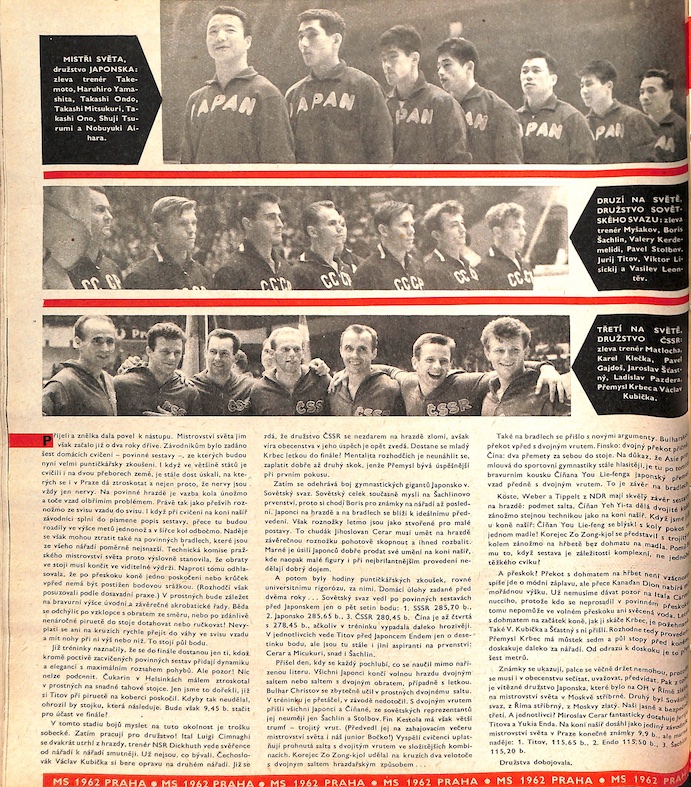
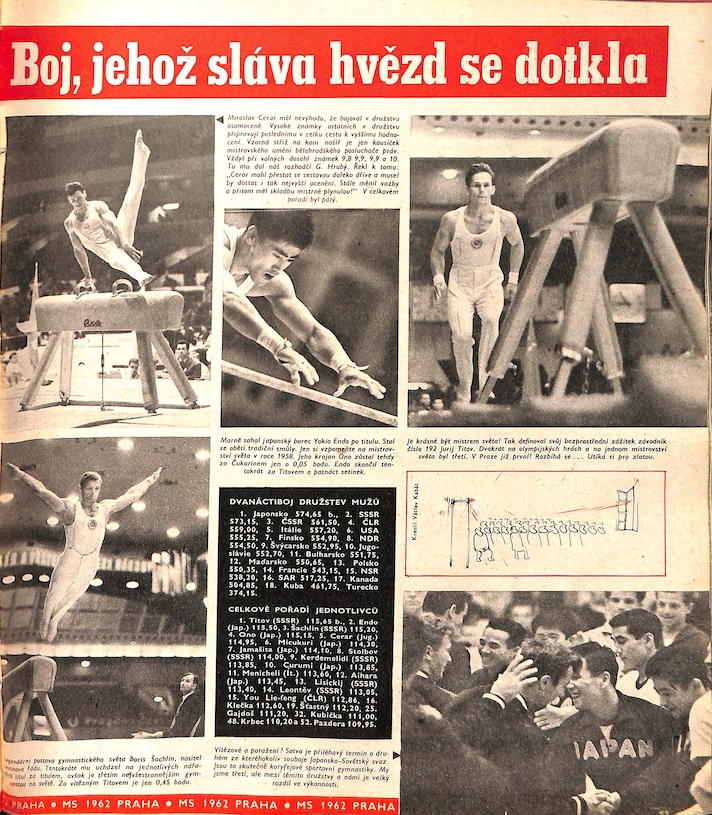
The Main Article
The fight whose glory touched the stars
They arrived and the signal was given to take position. However, the World Championships had started already two years earlier. The athletes had been given six exercises to practice at home — compulsory routines — which they would now be tested on very meticulously. Even though they have been practiced at two national championships in most countries, there are still plenty of pitfalls to fail at even in Prague, and not just because nerves are always just that. Nerves. On the compulsory high bar, the linking of straddle circles and turns with grip changes is a huge problem. Just like the straddle cut. Even if, on pommel horse, the athletes fulfill the description of the routine to the letter, there will still be differences in the height of the single leg cuts and in the width of the circles. However, hopes may also be lost on the compulsory parallel bars, which are relatively the easiest of all the apparatuses. The Technical Commission of the Prague World Championships has therefore explicitly stipulated that handstand pirouettes must end in a visible hold. On the other hand, they voted that after the vault, one hop or step forward should not be penalized with a point deduction. (The judges, however, judged according to the previous practice.) On floor exercise, the bravura height of the opening and closing acrobatic lines will matter. Beware of deviating after a flip with a turn of direction, or after a seemingly effortless handstand pirouette to straighten up or use a hand movement! Nor does it pay off to go quickly to the back lever on the rings and have your feet higher or lower during it. This costs half a point.
[Note: You can find the compulsory routines for the 1962 World Championships here.]
Already the training sessions indicated that only those who add dynamics and elegance with a maximum range of movement in addition to honestly practiced compulsory routines will make it into the finals. But beware! Nothing can be underestimated, Chukarin almost crashed in Helsinki [in 1952] on floor in an easy handstand. Just as we were finishing, Titov already took a hop on the carpet during the pirouette. If he hadn’t, he would have jeopardized the handstand that follows. But will a 9.45 be enough for the final?
To think of this circumstance at this stage of the competition is a bit selfish. For now, they’re working for the team! Italian Luigi Cimnaghi fell off the bar twice, West German coach Dickhuth leads his athletes from apparatus to apparatus more sadly. They’re not what they used to be. Czechoslovakian Václav Kubička repeats his routine on the second apparatus. Already it seems that the Czechoslovak team will not be broken by the failure on high bar, as the crowd’s faith in their success lifts them again. Will Krbec make it to the final? The mentality of the judges is not to rush, to pay well [i.e. give a high score] until the second vault, but Přemysl tends to be more successful on the first attempt.
Meanwhile, the battle of the gymnastic giants, Japan v. Soviet Union, is going on. At the same time, the Soviet team is thinking about Shakhlin’s first place, so Boris is the last one to get his scores. The Japanese on horizontal bar and on parallel bars are close to a perfect performance. However, the straddle hecht is perfect for small figures. Poor Yugoslav Cerar [a tall gymnast] who must be able to kick his legs over the bar on the final straddle hecht and immediately straighten out. In vain are the efforts of the Japanese to sell their art well on the pommel horse, where, on the contrary, small figures, even with the most brilliant execution, do not make a good impression.
And then the hours of meticulous exams, equivalent to a doctoral oral exam, were over. Homework assignments from two years ago… After the compulsory routines, the Soviet Union led Japan by just five-hundredths of a point: 1st USSR 285.70 points, 2nd Japan 285.65 points, 3rd CSSR 280.45 points. China only came fourth with 278.45 points, although they looked far more formidable in training. In the individual competition, Titov leads Japan’s Endo by only a tenth of a point, but there are still other aspirants for the top spot: Cerar and Mitsukuri, perhaps even Shakhlin.
The day has come when everyone will boast about what they have learned outside the prescribed letter. All the Japanese end the optional horizontal bar with a double back or a full twist or a hecht. Bulgaria’s Christov learned the double somersault unnecessarily on floor. In practice, he over-rotated them; in competition, he didn’t complete the rotation. All the Japanese and Chinese came up with the double somersault, only Shakhlin and Stolbov of the Soviet representatives can’t do it. Finn Kestola, however, has a bigger trump card – the 1.5 twist. (Our junior Bočko also performed it at the opening night World Championships!) Advanced practitioners use full-twisting saltos in more complex combinations. The Korean Zo Zong-kjol did two giant swings on the rings with a double flip in a horizontal bar manner…
New arguments were made on parallel bars, too. Bulgaria: forward flip with a full twist. Finland: double somersault off the side. China: two back tosses to handstand. To prove that Asia is speaking louder and louder in the sport of gymnastics, after this bravura stunt by China’s You Lie-feng, here comes Japanese back somersault with a full twist. That’s the finish on the parallel bars.
Köste, Weber, and Tippelt from the GDR have a great end of the routine on the horizontal bar: salto from an underswing. Chinese Yeh Yi-Ta does a Wende swing with the same technique as on pommel horse.* Speaking of pommel horse: China’s Yu Lie-feng boasted a circle on one handle! Korean Zo Zong-Kyol showed a triple Russian Wende swing without catching the handle. Will it help him when the routine is a matter of complexity, not one difficult exercise?
[*Note: Though the apparatus is not mentioned in the article, I believe that Yeh performed the Russian Wende swing (“kole zánožmo”) on parallel bars.]
And the vault? The handspring touching the back of the horse is not a rarity rather it is a fashionable flood, but still, Canadian Dion is gaining extraordinary height. We don’t have to watch out for Italian Carminucci anymore, because whoever didn’t make the compulsory vault, even holy water won’t help them in the optional vault. There are plenty of hechts with touching the top of the horse, the way Krbec does it. Kubička and Št’astný used this vault, as well. So execution will be the decisive factor. Přemysl Krbec has the board seven and a half feet in front of the horse, he vaults far behind the apparatus.
Scores are shown, fingers cannot be crossed forever, because the audience has to count, consider, and predict. The winner is Japan, which was golden at the Olympics in Rome and silver at the World Championships in Moscow. Second was the Soviet Union, silver in Rome, gold in Moscow. Our team is clearly and safely third. And the individuals? Miroslav Cerar is fantastically close to Yuri Titov and Endo Yukio. On pommel horse, he was the only athlete at the World Championships in Prague to achieve a final score of 9.9 points, but a vain hope: 1st Titov, 115.65 points, 2nd Endo 115.50 points, 3rd Shakhlin 115.20 points.
Boj, jehož sláva hvězd se dotkla
Přijeli a znělka dala povel k nástupu. Mistrovství světa jim však začalo již o dva roky dříve, Závodníkům bylo zadáno šest domácích cvičení — povinné sestavy —, ze kterých budou nyní velmi puntičkářsky zkoušení. I když ve většině států je cvičili i na dvou přeborech země, je stále dost úskalí, na kterých se i v Praze dá ztroskotat a nejen proto, že nervy jsou vždy jen. Nervy. Na povinné hrazdě je vazba kola únožmo a toče vzad olbřímím problémem. Právě tak jako přešvih roznožmo ze svisu vzadu do svisu. I když při cvičení na koni našíř závodníci splní do písmene popis sestavy, přece tu budou rozdíly ve výšce metů jednonož a v šířce kol odbočmo. Naděje se však mohou ztratit také na povinných bradlech, které jsou ze všeho nářadí poměrně nejsnazší. Technická komise pražského mistrovství světa proto výslovně stanovila, že obraty ve stoji musí končit ve viditelné výdrži. Naproti tomu odhlasovala, že po přeskoku koně jedno poskočení nebo krůček vpřed nemá být postižen bodovou srážkou. (Rozhodčí však posuzovali podle dosavadní praxe.) V prostných bude záležet na bravurní výšce úvodní a závěrečné akrobatické řady. Běda se odchýlit po vzklopce s obratem ze směru, nebo po zdánlivě, nenáročné piruetě do stoje dotahovat nebo ručkovat! Nevyplatí se ani na kruzích rychle přejít do váhy ve svisu vzadu a mít nohy při ní výš nebo níž. To stojí půl bodu.
Již tréninky naznačily, že se do finále dostanou jen ti, kdož kromě poctivě zacvičených povinných sestav přidají dynamiku a elegancí s maximálním rozsahem pohybů. Ale pozor! Nic nelze podcenit, Čukarin v Helsinkách málem ztroskotal v prostných na snadné tahové stojce. Jen jsme to dořekli, již si Titov při piruetě na koberci poskočil. Kdyby tak neudělal, ohrozil by stojku, která následuje. Bude však 9,45 b. stačit pro účast ve finále?
V tomto stadiu bojů myslet na tuto okolnost je trošku sobecké. Zatím pracují pro družstvo! Ital Luigi Cimnaghi se dvakrát utrhl z hrazdy, trenér NSR Dickhuth vede svěřence od nářadí k nářadí smutněji. Už nejsou, co bývali. Čechoslovák Václav Kubička si bere opravu na druhém nářadí. Již se zdá, že družstvo ČSSR se nezdarem na hrazdě zlomí, avšak víra obecenstva v jeho úspěch je opět zvedá. Dostane se mladý Krbec letkou do finále? Mentalita rozhodčích je neunáhlit se, zaplatit dobře až druhý skok, jenže Přemysl bývá úspěšnější při prvním pokusu.
Zatím se odehrává boj gymnastických gigantů Japonsko v. Sovětský svaz. Sovětský celek současně myslí na Šachlinovo prvenství, proto si chodí Boris pro známky na nářadí až poslední. Japonci na hrazdě a na bradlech se blíží k ideálnímu předvedení. Však roznožky letmo jsou jako stvořené pro malé postavy. To chudák Jihoslovan Cerar musí umět na hrazdě závěrečnou roznožku pohotově skopnout a ihned rozbalit. Marné je úsilí Japonců dobře prodat své umění na koni našíř, kde naopak malé figury i při nejbrilantnějším provedení nedělají dobrý dojem.
A potom byly hodiny puntičkářských zkoušek, rovné universitnímu rigorózu, za nimi. Domácí úlohy zadané před dvěma roky… Sovětský svaz vedl po povinných sestavách před Japonskem jen o pět setin bodu: 1. SSSR 285,70 b., 2. Japonsko 285,65 b., 3. ČSSR 280,45 b. Čína je až čtvrtá s 278,45 b., ačkoliv v tréninku vypadala daleko hrozivěji. V jednotlivcích vede Titov před Japoncem Endem jen o desetinku bodu, ale jsou tu stále i jiní aspiranti na prvenství: Cerar a Micukuri, snad i Šachlin.
Přišel den, kdy se každý pochlubí, co se naučil mimo nařízenou literu. Všichni Japonci končí volnou hrazdu dvojným saltem nebo saltem s dvojným obratem, případně s letkou. Bulhar Christov se zbytečně učil v prostných dvojnému saltu. V tréninku je přetáčel, v závodě nedotočil. S dvojným vrutem přišli všichni Japonci a Číňané, ze sovětských reprezentantů jej neumějí jen Šachlin a Stolbov. Fin Kestola má však větší trumf — trojitý vrut. (Předvedl jej na zahajovacím večeru mistrovství světa i náš junior Bočko!) Vyspělí cvičenci uplatňují prohnutá salta s dvojitým vrutem ve složitějších kombinacích. Korejec Zo Zong-kjol udělal na kruzích dva velotoče [giant swings] s dvojným saltem hrazdařským způsobem…
Také na bradlech se přišlo s novými argumenty. Bulharské překot vpřed s dvojným vrutem. Finsko: dvojný překot příčně. Čína: dva přemety za sebou do stoje. Na důkaz, že Asie promlouvá do sportovní gymnastiky stále hlasitěji, je tu po tomto bravurním kousku Číňana You Lie-fenga japonský přemet vzad předně s dvojným vrutem. To je závěr na bradlech.
Köste, Weber a Tippelt z NDR mají skvělý závěr sestavy na hrazdě: podmet salta. Číňan Yeh Yi-ta dělá dvojité kole zánožmo stejnou technikou jako na koni našíř. Když jsme již u koně našíř: Číňan You Lie-feng se blýsk! s koly pokos na jednom madle! Korejec Zo Zong-kjol se představil s trojitým kolem zánožmo na hřbetě bez dohmatu na madla. Pomůže mu to, když sestava je záležitostí komplexní, ne jednoho těžkého cviku?
A přeskok? Překot s dohmatem na hřbet není vzácností spíše jde o módní záplavu, ale přece Kanaďan Dion nabírá mimořádnou výšku. Už nemusíme dávat pozor na Itala Carminucciho, protože kdo se neprosadil v povinném přeskoku, tomu nepomůže ve volném přeskoku ani svěcená voda. Letek s dohmatem na začátek koně, jak ji skáče Krbec, je požehnaně Také V. Kubička a Šťastný: s ní přišli. Rozhodne tedy provedení. Přemysl Krbec má můstek sedm a půl stopy před koněm, doskakuje daleko za nářadí. ho odrazů k doskoku je to přes šest metrů.
Známky se ukazují, palce se věcné držet nemohou, protože se musí i v obecenstvu sečítat, uvažovat, předvídat. Pak a toho je vítězné družstvo Japonska, které bylo na OH v Římě ž zlaté, na mistrovství světa V Moskvě stříbrně. Druhý byl Sovětský svaz, z Říma stříbrný, z Moskvy zlatý. Naši jasně a bezpečně třetí. A jednotlivci? Miroslav Cerar fantasticky dotahuje Jurije Titova a Yukia Enda. Na koni našíř dosáhl jako jediný závodník mistrovství světa v Praze konečné známky 9,9 b., ale marná naděje: 1. Titov, 115,65 b., 2. Endo 115,50 b., 3 Šachlin 115,20 b.
Photo Captions
Miroslav Cerar had the disadvantage that he fought alone in the team. The high scores of the others in the team pave the way for the last one in the rotation to get a higher score. An exemplary scissors on the pommel horse is just a piece of the Belgrade law student’s mastery. After all, in the optional portion, he achieved scores of 9.8, 9.9, and 10. The score was given by our judge G. Hrubý. He said: “Cerar could have stopped the exercise much earlier and he would have had to get the highest award anyway. He kept changing the linking elements and yet his composition was masterfully fluent!” He was fifth overall.
Japanese athlete Endo Yukio tried in vain for the title. He became a victim of traditional bad luck. Just think of the 1958 World Championships. His compatriot Ono was only 0.05 points behind Chukarin. Endo finished 15 hundredths behind Titov this time.
It’s nice to be a world champion! That’s how Yuri Titov, athlete number 192, defined his immediate experience. Twice at the Olympics and once at the World Championships he was third. In Prague, finally first! He starts running… He’s going for the gold.
Legendary figure of the gymnastics world Boris Shakhlin, holder of the Order of Lenin. This time he claimed title after title on individual apparatuses, but he is the third most versatile gymnast in the world. He is just 0.45 points behind winner Titov.
Winners and losers? The latter is hardly an apt term for any in Japan-Soviet Union duel. They are truly the coryphaeuses of the sport of gymnastics. We’re third, but there’s a big difference in performance between these teams and us.
[Note: The coryphaeuses were the leaders of a chorus in an Ancient Greek drama.]
Miroslav Cerar měl nevýhodu, že bojoval v družstvu osamoceně. Vysoké známky ostatních v družstvu připravují poslednímu v celku cestu k vyššímu hodnocení. Vzorná stříž na koni našíř je jen kousíček mistrovského umění bělehradského posluchače práv. Vždyť při volných dosáhl známek 9,8 9,9, 9,9 a 10. Tu mu dal náš rozhodčí G. Hrubý. Řekl k tomu: „Cerar mohl přestat se sestavou daleko dříve a musel by dostat i tak nejvyšší ocenění. Stále měnil vazby a přitom měl skladbu mistrně plynulou!“ V celkovém pořadí byl pátý.
Marně sahal japonský borec Yukio Endo po titulu. Stal se obětí tradiční smůly. Jen si vzpomeňte na mistrovství světa v roce 1958. Jeho krajan Ono zůstal tehdy za Čukarinem jen o 0,05 bodu. Endo skončil tentokrát za Titovem o patnáct setinek.
Je krásné být mistrem světa! Tak definoval svůj bezprostřední zážitek závodník číslo 192 Jurij Titov. Dvakrát na olympijských hrách a na jednom mistrovství světa byl třetí. V Praze již první! Rozbíhá se… Utíká si pro zlatou.
Legendární postava gymnastického světa Boris Šachlin, nositel Leninova řádu. Tentokráte mu ucházel na jednotlivých nářadích titul za titulem, avšak je třetím nejvšestrannějším gymnastou na světě. Za vítězným Titovem je jen 0,45 bodu.
Vítězové a poražení? Sotva je přiléhavý termín o druhém ze kteréhokoliv souboje Japonsko-Sovětský svaz. Jsou to skutečně koryfejové sportovní gymnastiky. My jsme třetí, ale mezi těmito družstvy a námi je velký rozdíl ve výkonnosti.
The Women’s Competition
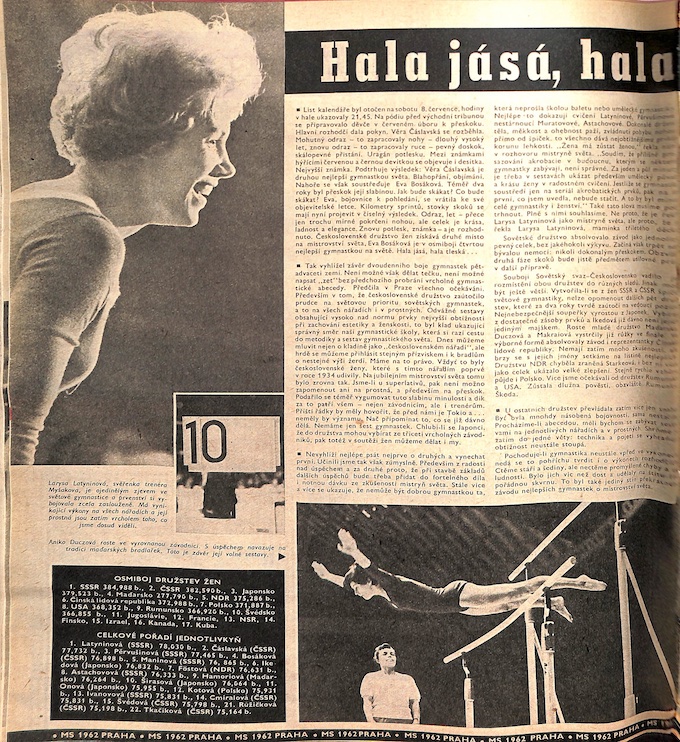
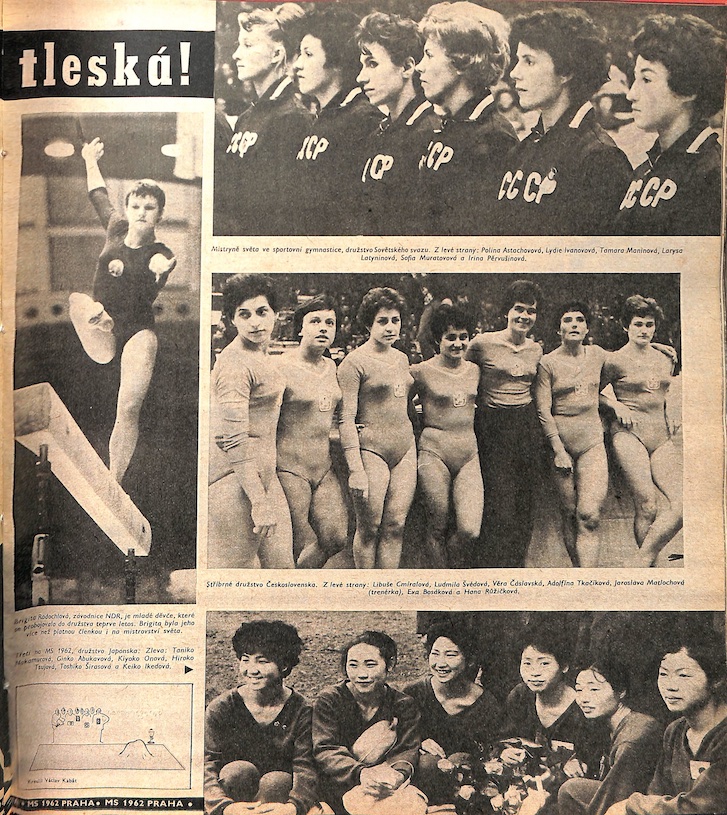
The Main Article
The hall cheers, the hall applauds!
• The calendar page was turned to Saturday, July 8, and the clock in the hall showed 9.45 p.m. On the stage in front of the East Stand, a girl in a red outfit was preparing to vault. The head referee gave the cue. Věra Čáslavská came running. A mighty bounce – the legs working – a long high flight, another bounce – the hands working – a solid landing. A hurricane of applause. Amongst the scores teeming with red and black nines, there’s a ten. The highest score. It underlines the result: Věra Čáslavská is the second best gymnast in the world. Congratulations, hugs. But Eva Bosáková is concentrating up there. For almost two years, the vault has been her weakness. How will she vault? What will she vault? Eva, a warrior to behold, has returned to her exploratory flight. Miles of sprints, hundreds of vaults are now about to translate into a numerical result. The bounce, the flight – after all, just a slight bend in the legs, but the overall impression is beauty, grace, and elegance. Applause again, a score – and it’s decided. The Czechoslovak women’s team wins second place at the World Championships, Eva Bosáková is the fourth best gymnast in the world in the all-around. The hall cheers, the hall applauds…
• This was the conclusion of the two-day battle of gymnasts from twenty-five countries. But it is impossible to make a full stop, it is impossible to write the final letter “Z” without first going through the top gymnastic alphabet. It exceeded all expectations in Prague. First of all, the Czechoslovak team attacked the global hegemony of the Soviet gymnasts sharply, both in the all-around and on floor exercise. Bold routines containing elements of the highest difficulty well above the norm while maintaining aesthetics and femininity were a positive sign of the right direction of our gymnastics school, which is making its way into the methodology and routines of the gymnastics world. Today, we can not only speak of the balance beam as “the Czechoslovakian apparatus,” but we can proudly claim the same moniker for the uneven bars. We have the right to do so. After all, it was the Czechoslovak women who first astonished with this apparatus in 1934, and it was the same at the Jubilee World Championships. If we’re talking about superlatives, then we can’t forget about the floor exercise and especially the vault. It was possible to almost eradicate this weakness of the past, and thanks for that go to everyone – not only the athletes, but also the coaches. On the following lines we should write that Tokyo is ahead of us and… but they wouldn’t have no meaning. It’s a reminder of what has been done for a long time. We don’t just have six gymnasts. If the Japanese men boast that they can select from thirty top athletes for the team, then we can do the same in the women’s competition.
• It is not best to write about the latter first and leave out the former. But we have done so deliberately. First of all out of joy at the success and secondly because in building the foundations of further successes it will be necessary to add a good dose of the experience of the world champions to the hard work. It is becoming more and more evident that one cannot be a good gymnast unless they have passed the school of ballet or artistic gymnastics. This is best demonstrated by the exercises of Latynina, Pervushina, the ageless Muratova, Astakhova. The perfect posture, the softness and flexibility of the arms, the mastery of the movement of the legs right from the toes, all this gives the most difficult element the crown of lightness. “A woman should remain a woman,” the world champion told us in an interview. “I judge that the over-promotion of acrobatics in the future that some gymnasts are engaged in is not right. For one and a half minutes, the artistic grace and beauty of a woman in a joyful exercise should be shown above all in routines. If a gymnast concentrates only on a series of acrobatic elements, then it will not be enough for the thing I have mentioned first. And that would be the downside of all gymnastics and womanhood.” We must underline these words. We fully agree with them. Not because they were said by Larisa Latynina as a world champion, but because they were said by Larisa Latynina, a mom of a three-year-old.
The Soviet team completed the competition as a single, solid unit, without any fluctuations. However, it is beginning to suffer from our former malady: the imperfect vault. Especially the second flight phase will certainly be the subject of hard work in further preparation.
The Soviet Union-Czechoslovakia duel was marred only by the placement of the two teams in different subdivisions. Otherwise it could have been even bigger. If the women of the USSR and Czechoslovakia have formed the top of world gymnastics, one cannot forget the other five teams that will attack hard for the leading positions in two years. The most dangerous rivals will be the Japanese women. They choose from an ample supply of elements, and Ikeda has long been their only beacon. Hungary’s young team is growing. Ducza and Makrai have already made their mark in the finals. The representatives of the People’s Republic of China also finished the competition in excellent form. They don’t have much experience yet, but we will soon see their names on the best list. The GDR team was missing the injured Starke, but even without her, the team as a whole showed great improvement. Poland will go up just as fast. We expected more from the Romanian and U.S. teams. They remain indebted to their reputation, especially the Romanians. Too bad.
• Other teams were merely trying so far. Although their efforts were often multiplied by combativeness, it was not enough on its own. Going through the alphabet, we should deal with the routines on the individual apparatuses and floor exercise. Let’s summarize them in one sentence for the time being: technique and concept are becoming more sophisticated, the difficulty is constantly increasing.
If gymnastics is constantly moving forward in performance, the same cannot unfortunately be said about the performance of the judges. Let’s honor age and gray hair, but let’s not honor thoughtful mistakes and being malicious. There has been more than enough of that, and it has put a big stain on the FIG’s shield: It was also the only shadow of a beautiful World Championship competition for the best gymnasts.
Hala jásá, hala tleská!
• List kalendáře byl otočen na sobotu 8. července, hodiny v hale ukazovaly 21,45. Na pódiu před východní tribunou se připravovalo děvče v červeném úboru k přeskoku. Hlavní rozhodčí dala pokyn. Věra Čáslavská se rozběhla. Mohutný odraz — to zapracovaly nohy — dlouhý vysoký let, znovu odraz — to zapracovaly ruce — pevný doskok, skálopevné přistání. Uragán potlesku. Mezi známkami hýřícími červenou a černou devítkou se objevuje i desítka. Nejvyšší známka. Podtrhuje výsledek: Věra Čáslavská je druhou nejlepší gymnastkou světa. Blahopřání, objímání. Nahoře se však soustřeďuje Eva Bosáková. Téměř dva roky byl přeskok její slabinou. Jak bude skákat? Co bude skákat? Eva, bojovnice k pohledání, se vrátila ke své objevitelské letce. Kilometry sprintů, stovky skoků se mají nyní projevit v číselný výsledek. Odraz, let — přece jen trochu mírné pokrčení nohou, ale celek je krása, ladnost a elegance. Znovu potlesk, známka — a je rozhodnuto. Československé družstvo žen získává druhé místo na mistrovství světa, Eva Bosáková je v osmiboji čtvrtou nejlepší gymnastkou na světě. Hala jásá, hala tleská…
• Tak vyhlížel závěr dvoudenního boje gymnastek pětadvaceti zemí. Není možné však dělat tečku, není možné napsat „zet“ bez předchozího probrání vrcholné gymnastické abecedy. Předčila v Praze všechno očekávání. Především v tom, že československé družstvo zaútočilo prudce na světovou prioritu sovětských gymnastek, a to na všech nářadích i v prostných. Odvážné sestavy obsahující vysoko nad normu prvky nejvyšší obtížností při zachování estetiky a ženskosti, to byl klad ukazující správný směr naší gymnastické školy, která si razí cestu do metodiky a sestav gymnastického světa. Dnes můžeme mluvit nejen o kladině jako „československém nářadí“, ale hrdě se můžeme přihlásit stejným přízviskem i k bradlům o nestejné výši žerdi. Máme na to právo. Vždyť to byly československé ženy, které s tímto nářadím poprvé v roce 1934 udivily, Na jubilejním mistrovství světa tomu bylo zrovna tak. Jsme-li u superlativů, pak není možno zapomenout ani na prostná, a především na přeskok. Podařilo se téměř vygumovat tuto slabinu minulosti a dík za to patří všem — nejen závodnicím, ale i trenérům. Příští řádky by měly hovořit, že před námi je Tokio a… neměly by významu, Nač připomínat to, co se již dávno dělá. Nemáme jen šest gymnastek, Chlubí-li se Japonci, že do družstva mohou vybírat ze třiceti vrcholných závodníků, pak totéž v soutěži žen můžeme dělat i my.
• Nevyhlíží nejlépe psát nejprve o druhých a vynechat první. Učinili jsme tak však zúmyslně. Především z radosti nad úspěchem a za druhé proto, že při stavbě základů dalších úspěchů bude třeba přidat do fortelného díla i notnou dávku ze zkušeností mistryň světa. Stále více a více se ukazuje, že nemůže být dobrou gymnastkou ta, která neprošla školou baletu nebo umělecké gymnastiky. Nejlépe to dokazují cvičení Latyninové, Pěrvušinové, nestárnoucí Muratovové, Astachovové. Dokonalé držení těla, měkkost a ohebnost paží, zvládnutí pohybu nohou přímo od špiček, to všechno dává nejobtížnějšímu prvku korunu lehkosti. „Žena má zůstat ženou,” řekla nám v rozhovoru mistryně světa. „Soudím, že přílišné prosazování akrobacie v budoucnu, kterým se některé gymnastky zabývají, není správné. Za jeden a půl minuty je třeba v sestavách ukázat především umělecký půvab a krásu ženy v radostném cvičení. Jestliže se gymnastka soustředí jen na seriál akrobatických prvků, pak na to první, co jsem uvedla, nebude stačit. A to by byl mínus celé gymnastiky i ženství.” Také tato slova musíme podtrhnout. Plně s nimi souhlasíme. Ne proto, že je řekla Larysa Latyninová jako mistryně světa, ale proto, že je řekla Larysa Latyninová, maminka tříletého děcka.
Sovětské družstvo absolvovalo závod jako jednolitý, pevný celek, bez jakéhokoli výkyvu. Začíná však trpět naší bývalou nemocí: nikoli dokonalým přeskokem. Obzvlášť druhá fáze skoků bude jistě předmětem usilovné práce v další přípravě.
Souboji Sovětský svaz-Československo vadilo jen rozmístění obou družstev do různých sledů. Jinak mohl být ještě větší. Vytvořila-li se z žen SSSR a ČSSR špička světové gymnastiky, nelze opomenout dalších pět družstev, které za dva roky tvrdě zaútočí na vedoucí pozice. Nejnebezpečnější soupeřky vyrostou z Japonek. Vybírají z dostatečné zásoby prvků a Ikedová již dávno není jejich jediným majákem. Roste mladé družstvo Maďarska. Duczová a Makraiová vystrčily již růžky ve finále. Ve výborné formě absolvovaly závod i reprezentantky Činské lidové republiky. Nemají zatím mnoho zkušenosti, ale brzy se s jejich jmény setkáme na listině nejlepších Družstvu NDR chyběla zraněná Starkeová, i bez ni však jako celek ukázalo velké zlepšení. Stejně rychle vzhůru půjde i Polsko. Více jsme očekávali od družstev Rumunska a USA. Zůstala dlužna pověsti, obzvláště Rumunky. Škoda.
• U ostatních družstev převládala zatím více jen snaha Byť byla mnohdy násobená bojovností, sama nestačila. Procházíme-li abecedou, měli bychom se zabývat sestavami na jednotlivých nářadích a v prostných. Shrňme je zatím do jedné věty: technika a pojetí se vyhraňují, obtížnost neustále stoupá.
Pochoduje-li gymnastika neustále vpřed ve výkonech, nedá se to pohříchu tvrdit i o výkonech rozhodčích. Ctěme stáří a šediny, ale nectěme promyšlené chyby a záludnosti. Bylo jich, víc než dost a udělaly na štítu FIG pořádnou skvrnu: To byl také jediný stín překrásného závodu nejlepších gymnastek o mistrovství světa.
The Photo Captions
Larisa Latynina, trained by coach Mishakov, is a unique phenomenon in world gymnastics and she won the championship quite deservedly. Her performances on all apparatuses are excellent and her routines are the highlight of what we have seen so far.
Anikó Ducza is growing into a balanced athlete. She is successfully following the tradition of Hungarian females on uneven bars. This is the end of her optional routine.
Birgit Radochla, representing the GDR, is a young girl who only made it to the team this year. Brigita was a more than valid member of the team at the World Championships.
Larysa Latyninová, svěřenka trenéra Myšakova, je ojedinělým zjevem ve světové gymnastice a prvenství si vybojovala zcela zaslouženě. Má vynikající výkony na všech nářadích a její prostná jsou zatím vrcholem toho, co jsme dosud viděli.
Aniko Duczová roste ve vyrovnanou závodnici. S úspěchem navazuje na tradici maďarských bradlařek. Toto je závěr její volné sestavy.
Brigita Radochlová, závodnice NDR, je mladé děvče, které se probojovalo do družstva teprve letos. Brigita byla jeho více než platnou členkou i na mistrovství světa.
Štart’s Coverage
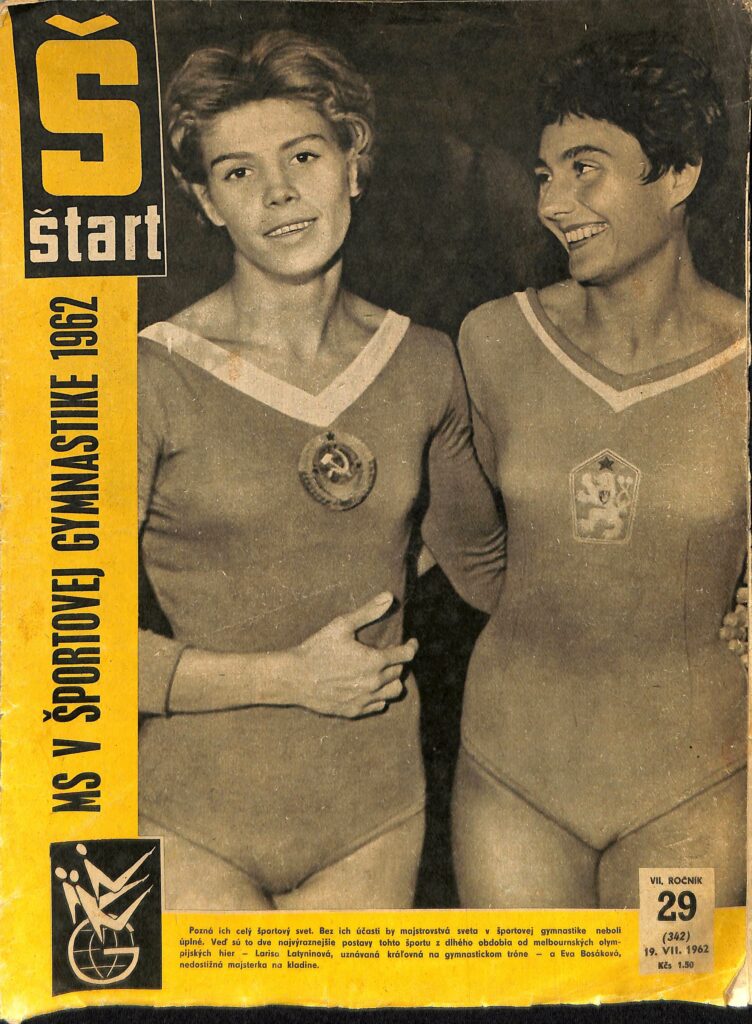
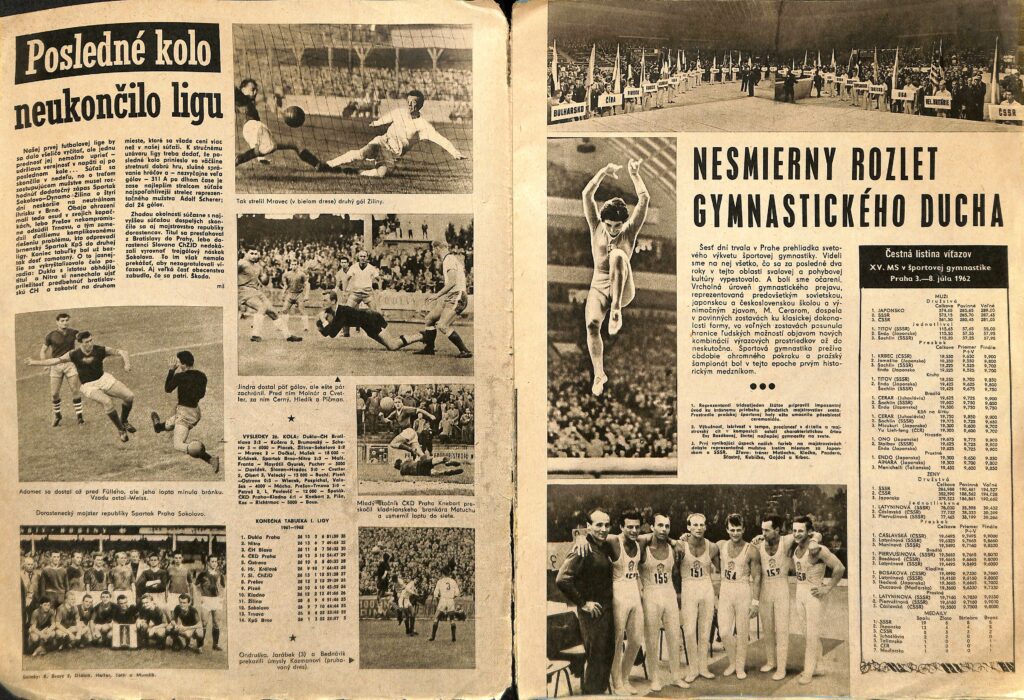
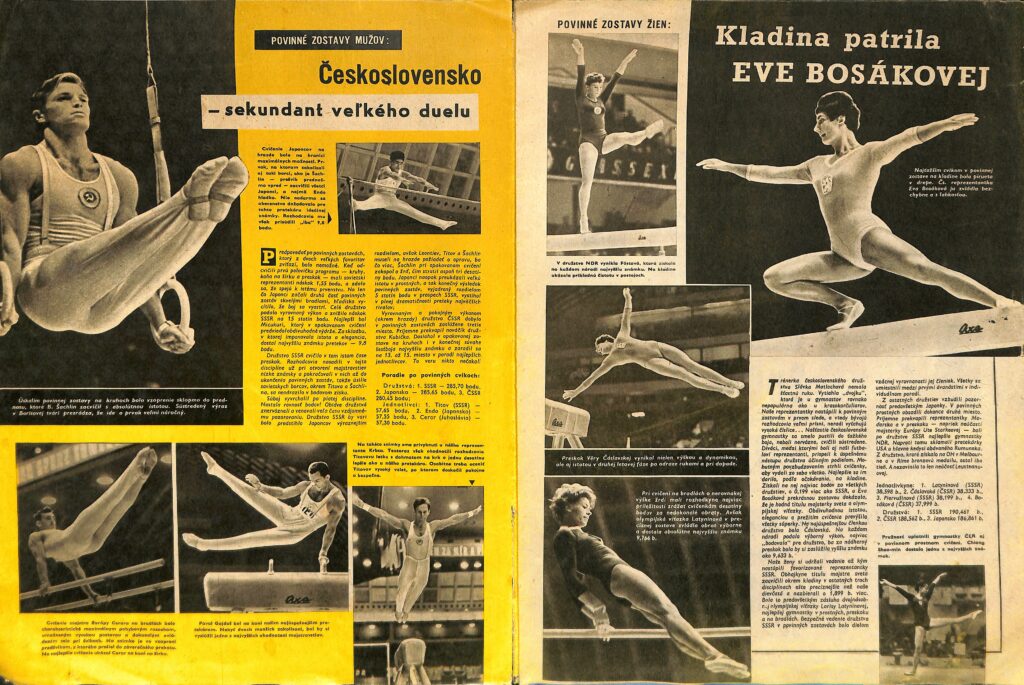
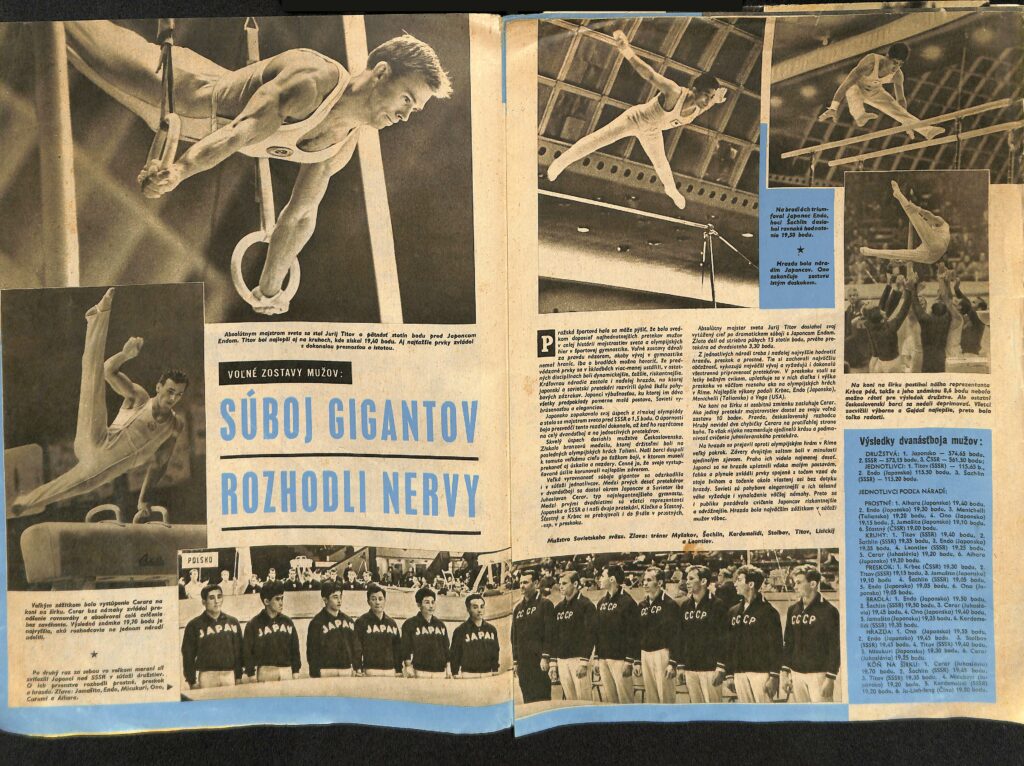
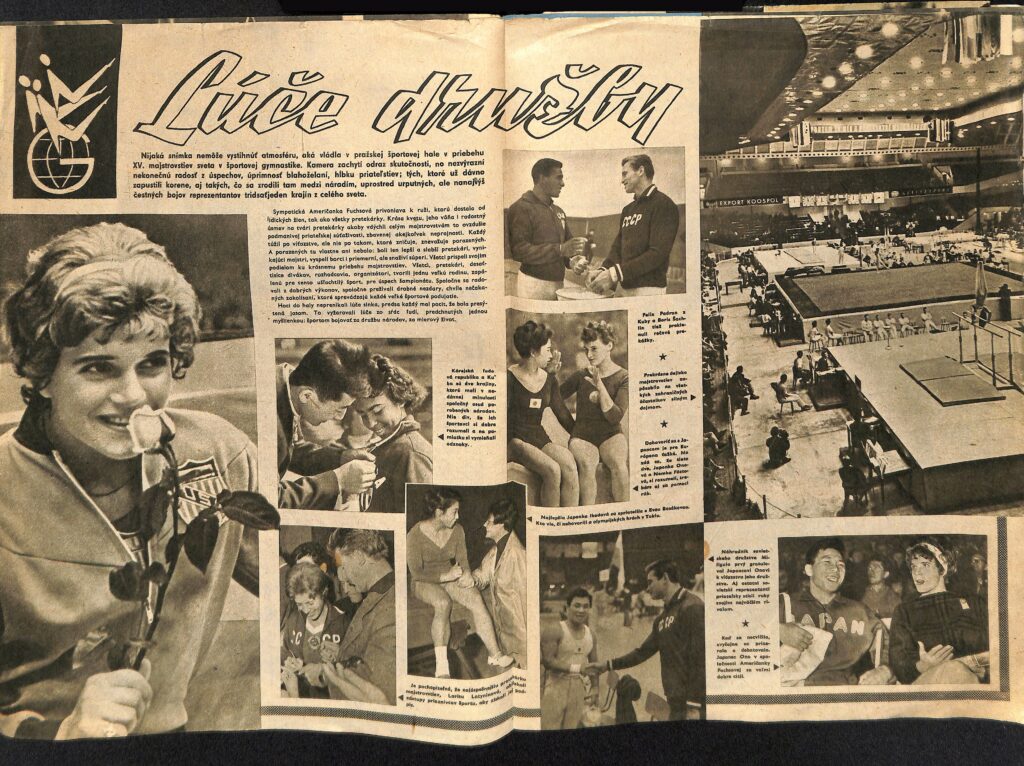
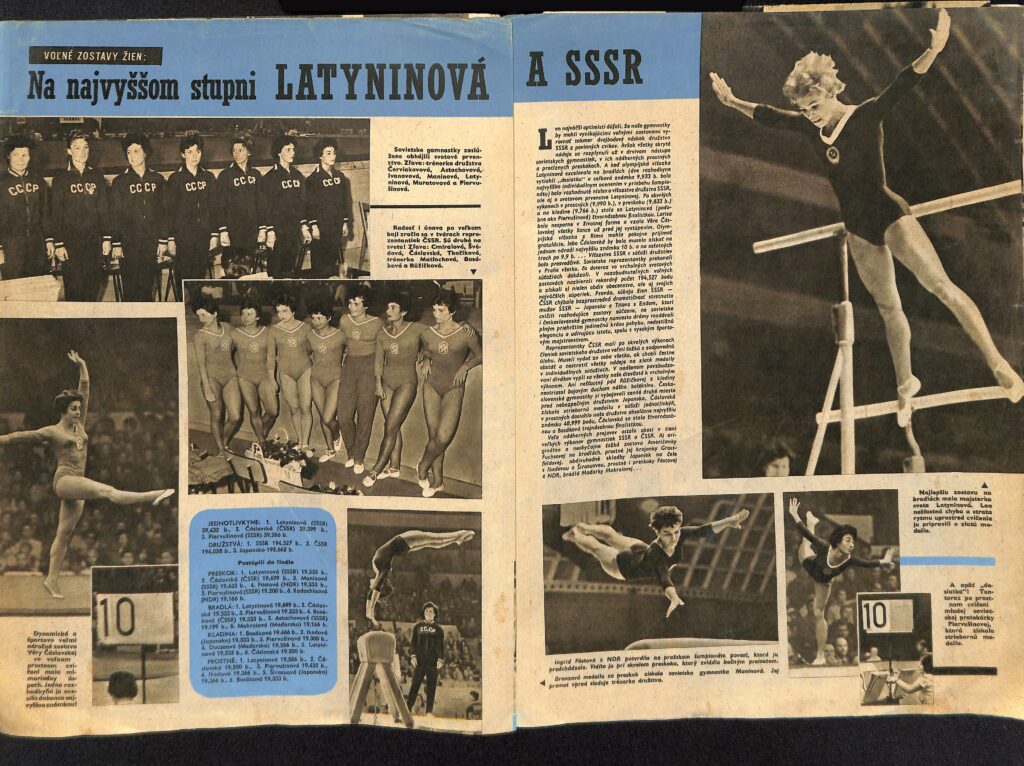
“Věra Čáslavská’s dynamic and athletically very demanding routine achieved exceptional success on the optional floor exercise. One judge even awarded her the highest score!”
“Dynamická a športovo veľmi náročná zostava Věry Čáslavskej vo voľnom prostnom cvičení mála mimoriadny úspech. Jedna rozhodkyňa ju ocenila dokonca najvyššouznámkou!”
“And when the Olympic champion Latynina excelled on uneven bars (two judges drew a “ten” and the total score of 9.933 points was the highest individual score during the championship), not only was the victory of the USSR team decided, but also that of Latynina’s world championship.”
“A keď olympijská víťazka Latyninová excelovala na bradlách (dve rozhodkyne tiahli „desiatku“ a celková známka 9,933 b. bola najvyšším individuálnym ocenením v priebehu šampionátu) bolo rozhodnuté nielen o víťazstve družstva SSSR,
ale aj o svetovom prvenstve Latýninovej.”
“And again “ten”! This time after the floor exercise of the young Soviet competitor Pervuschina, who won the silver medal.”
“A opäť „desiatka“! Tentoraz po prostnom cvičení mladej sovietskej pretekárky Piervušinovej, ktorá získala striebornú medailu.”
Note: The magazine meant that a single judge gave Pervuschina a 10; she didn’t have a final score of a 10.
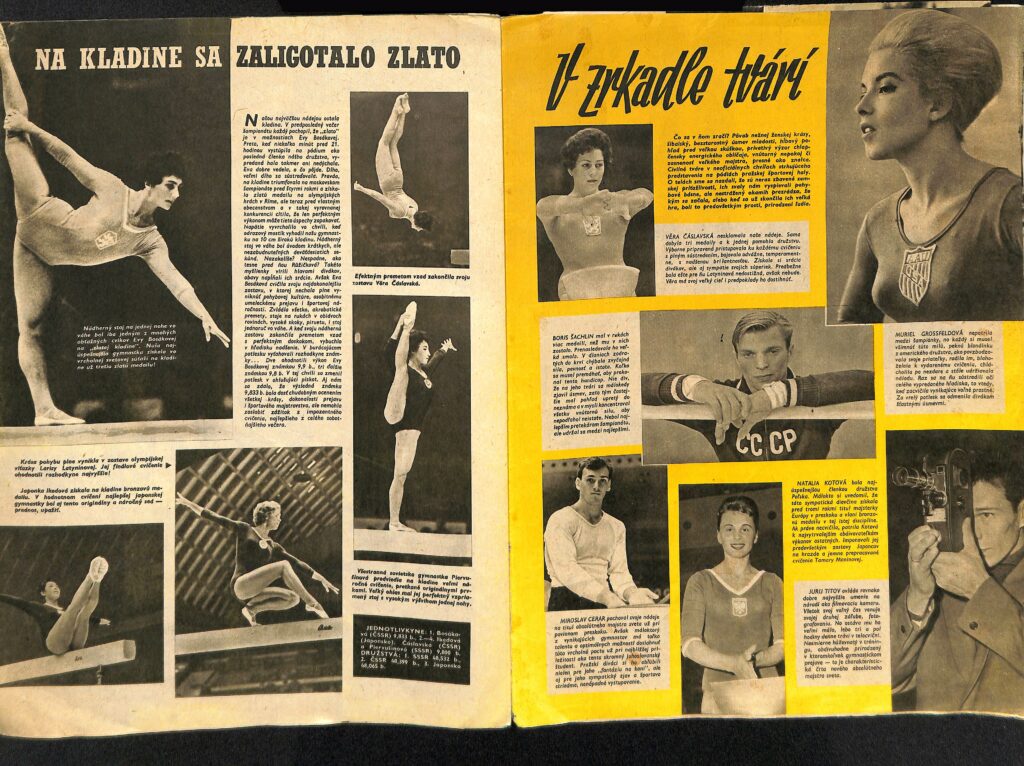
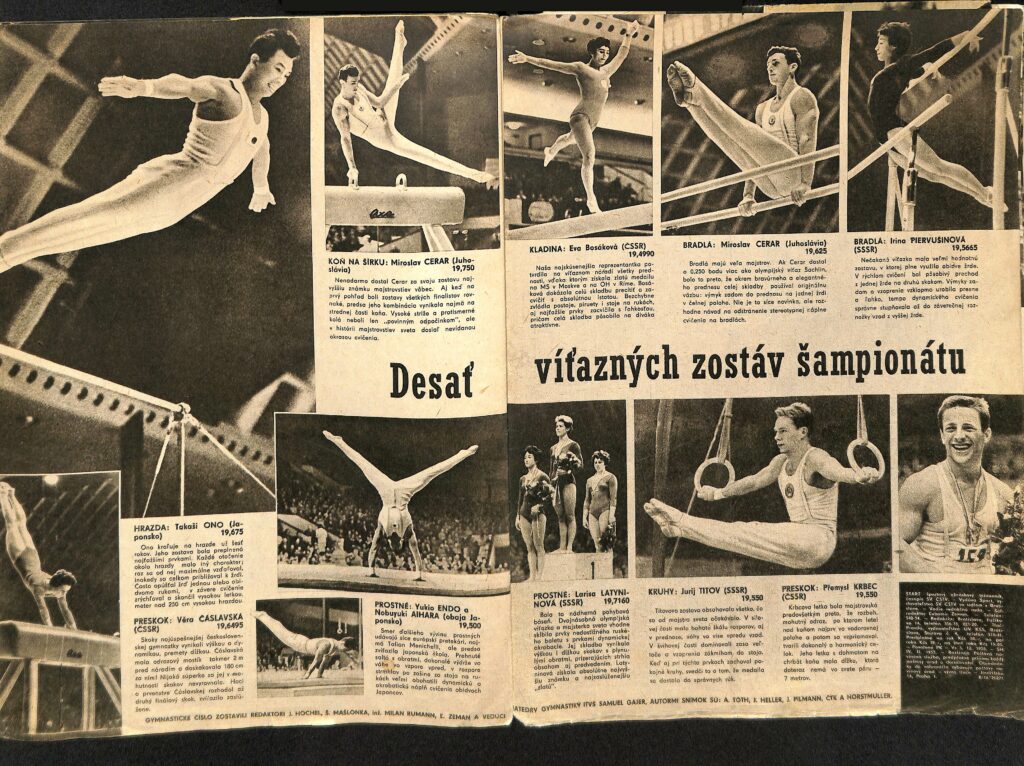
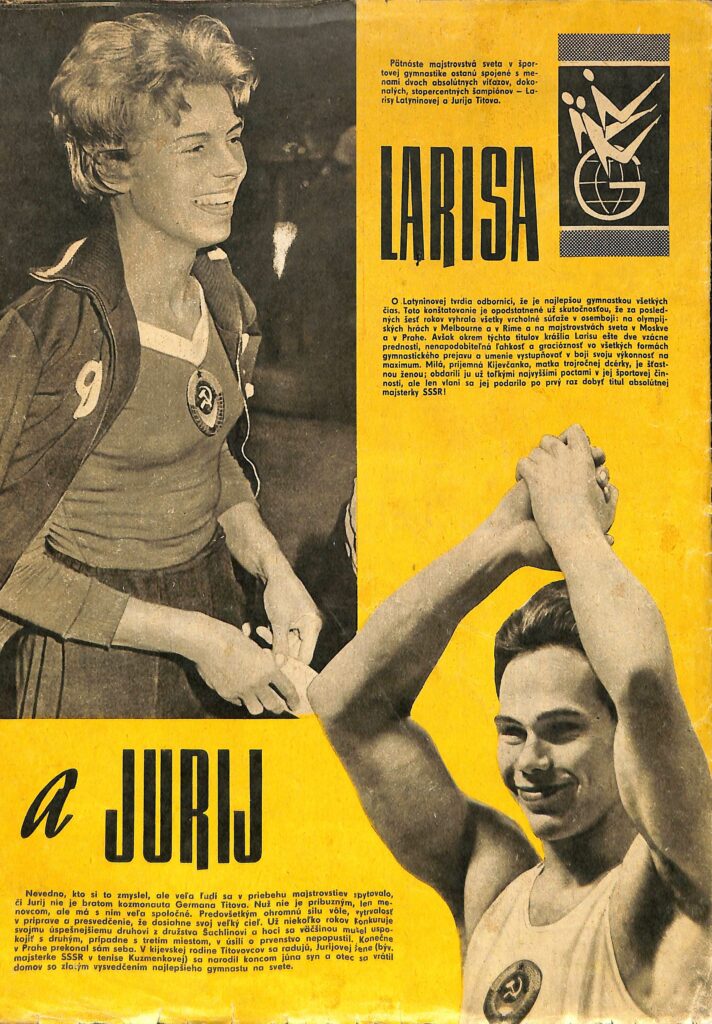
Note #1: You can read Berthe Villancher’s comments about the competition here. She was the President of the Women’s Technical Committee at the time.
Note #2: The judging of the parallel bars final was controversial, sparking discussions of abandoning the 10.0 for an open-ended system.
Note #3: Here are the main articles about the men’s and women’s competitions in Prague.
Note #4: It might be helpful to review the compulsory routines for the 1962 World Championships.
One reply on “1962: Czechoslovakia’s Coverage of the World Championships in Prague”
Hello, I am writing from a Croatian production company which is currently developing a documentary about Yugoslavia sport legends. I can’t find a contact email so could you please get in touch? Thank you!